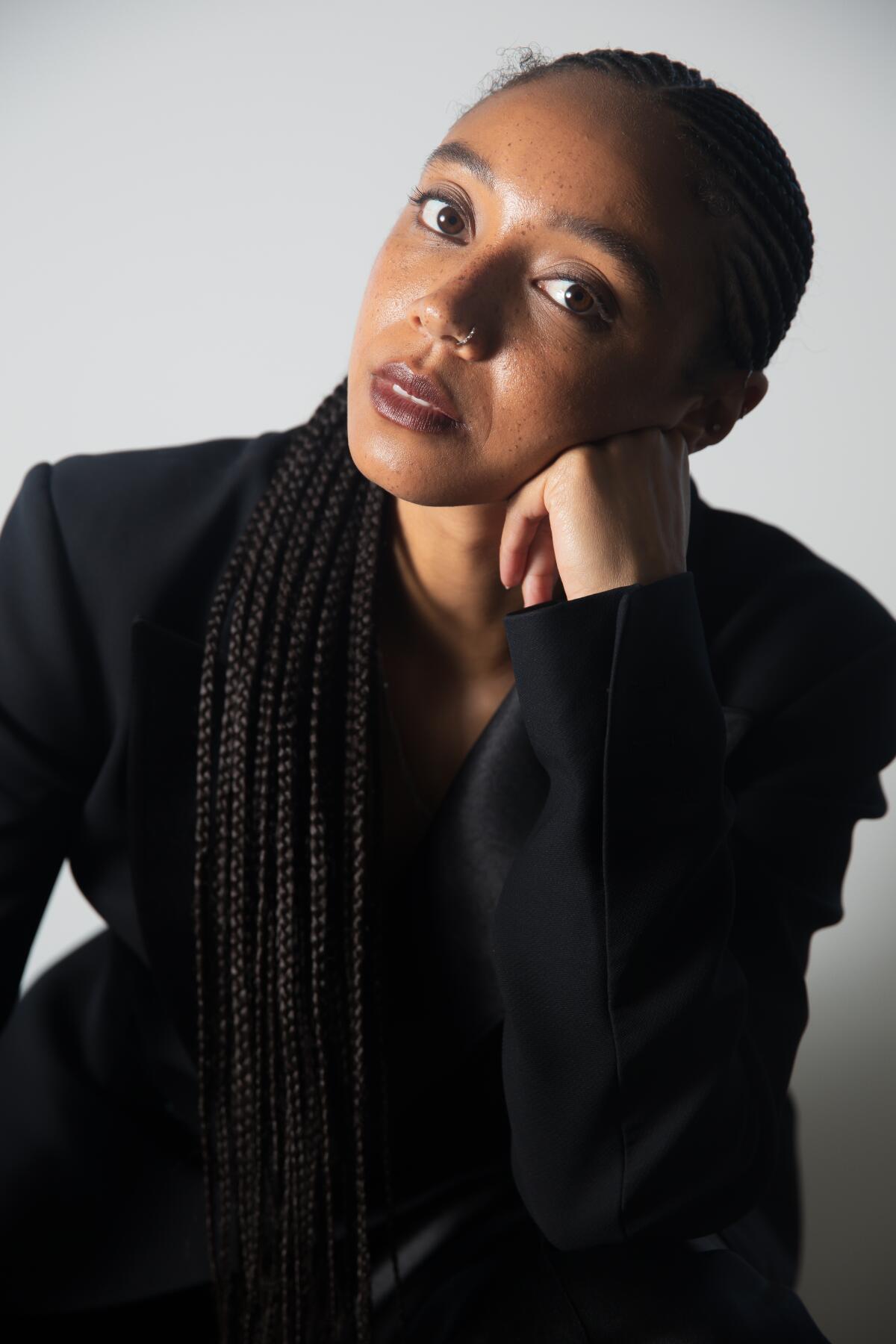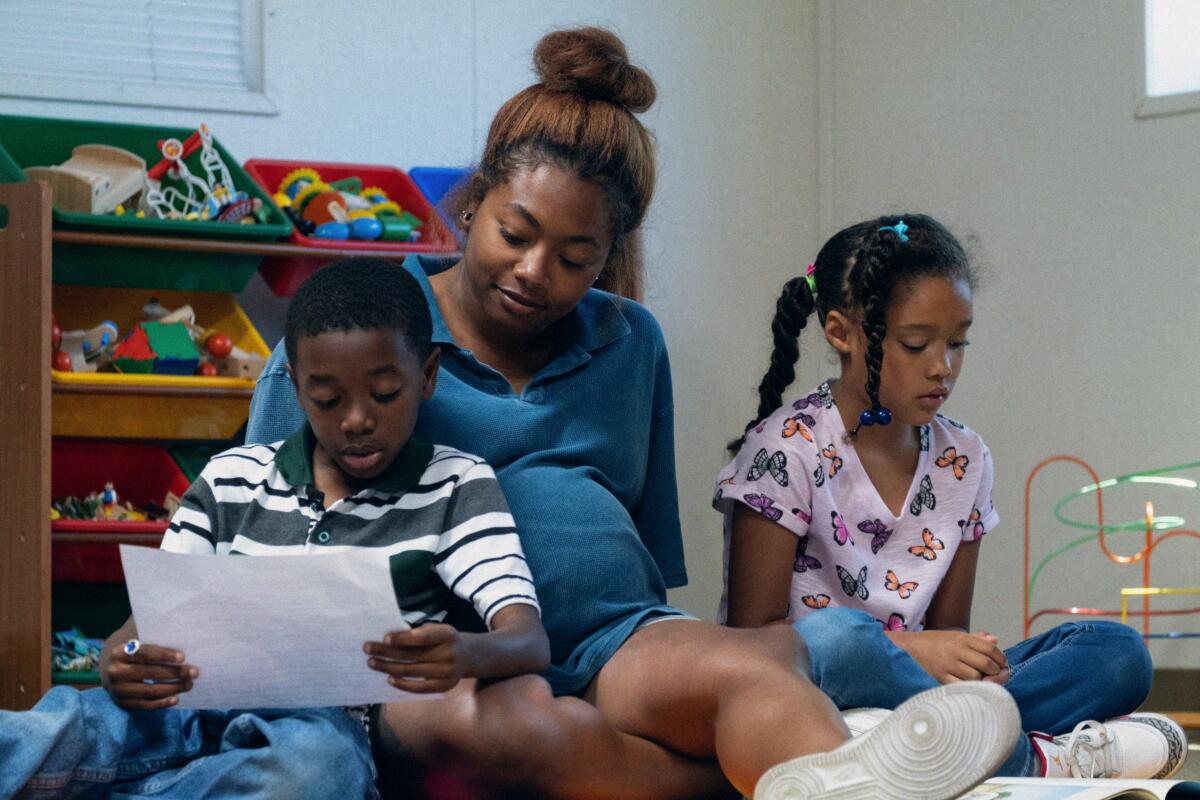Newsletter
Only good movies
Get the Indie Focus newsletter, Mark Olsen's weekly guide to the world of cinema.
You may occasionally receive promotional content from the Los Angeles Times.

Writer-director Savanah Leaf never forgot how her life changed at 16, when she met her future sister’s birth mother, a young woman not much older than herself.
“I felt very similar to her in many ways,” recalled the London-born, Bay Area-raised filmmaker, who drew inspiration from her own teenage memories for “Earth Mama,” her feature debut. “We were probably listening to the same music, both athletic. I was very curious about her.”
The Olympic volleyball player turned storyteller first explored her family’s experience in 2020’s “The Heart Still Hums,” a short documentary co-directed with “Bones and All” actor Taylor Russell following five mothers fighting addiction, poverty, generational trauma and the foster care system in Sacramento. That project in turn became “emotional research,” Leaf says, for the fictionalized “Earth Mama,” about a young Oakland mother in recovery for addiction, facing mounting legal, financial and emotional hardships with two children in foster care and a third on the way.

But “Earth Mama,” in theaters now, hinged on a pivotal piece of casting. For her protagonist Gia, who struggles to make ends meet working at a mall‘s portrait studio while fighting to restore her family, Leaf needed an actor who could bring naturalism, authentically rep the setting, and be ready for the challenge of carrying an entire film on her shoulders. Enter Tia Nomore.
The Oakland rapper, a recent mother with a 1-year-old at home who was then training to become a doula, had no previous acting experience. But her onscreen presence and resonance with the film’s themes made an impression on Leaf, who cast her at the center of an ensemble that includes Erika Alexander, Sharon Duncan-Brewster, Bokeem Woodbine, Dominic Fike and Olivia Luccardi. Rapper and singer Doechii also makes her acting debut in “Earth Mama,” which was shot on 16-millimeter by cinematographer Jody Lee Lipes in 26 days in and around Oakland.
During a recent stop in Los Angeles, Leaf and Nomore, both 29, sat down to discuss the personal connections that brought them to their evocative and critically acclaimed debut drama.
Savanah, you have a very personal connection to “Earth Mama.” How was it inspired by real life, as well as by your short documentary “The Heart Still Hums”?
Savanah Leaf: I wrote the first draft as a story about my sister and myself. It was built around these two scenes — one in the restaurant and one in the hospital — that were [drawn from] important moments in my life. I wanted to imagine what [my sister’s birth mother] was going through outside of those two scenes. I then made the short film with a friend of mine [Taylor Russell], just allowing these women to tell us about their lives. Some had children in foster care, some were foster-care children whose moms were struggling with addiction, and some had given their children up for adoption and were feeling the emotional toll of that. I read about people’s lives from all over the U.S. and brought myself into the script in every character. Gia was really my imagination of myself going through what she was going through.

What were you looking for in an actor who could play Gia?
Leaf: I had been searching for Gia for a while, working with our casting directors. We were looking at trained actors and people that had never acted before but had life experience that reflected the story. The dates of the shoot kept pushing because we were trying to find that person. It was terrifying. Because you’d meet these amazing actors but also wanted a sense of the Bay, and you can totally tell when someone’s putting on this Bay accent.
It’s a tough role. [We talked] about finding people on local basketball teams, musicians or dancers, people that are used to putting themselves in tough environments or had some sort of tough training. And then we found Tia. We met her in a park and recorded this video; Tia wasn’t wearing any makeup, she just rolled up and shared her experience as a mother and training to become a doula. That was one thing I was really looking for, someone who remembers the physicality of being a mother. When Tia went into this zone of being a mother, it was grounded and felt very tangible.
It wasn’t just the disproportionate number of pregnancy-related deaths among black women in the United States that alarmed Darline Turner when the crisis first hit the headlines.
So, Tia — you get a call to meet up in a park for a movie role ...
Tia Nomore: It was so sus — I had like three knives out on the table! But I hit it off with casting off top. We literally recorded that sitting under a tree. I was like, “I really want to sit on the ground and be one with the earth.” They were like, “Yes, come on.”
Were you already looking to get into film or acting?
Nomore: No, I was just barely holding it together being a stay-at-home mom. I actually was like, “I don’t have the capacity for this.” But I also didn’t think that they were going to choose me. I thought, either they are just using me for research or Savanah wants to be my friend in real life. Whatever it was, I was going with it. Whatever they asked for, I just tried my best at it. When I met [Leaf] in person, I didn’t want to leave her. She just really wanted to get to know me. She’d open questions by talking about her experience and say, “Do you have any feelings like that?” I think the more I learned about Savanah, the more I could dial into Gia.

How did you create connections and dynamics between characters, especially working with a cast of so many first-time actors?
Leaf: Everybody came together once Tia was in place, and we did six weeks of us, twice a week —
Nomore: Straight kicking it.
Leaf: We shared our life experiences. Tia met with Doechii and they went through the mall wearing [fake] bellies pretending to be best friends, which was really sweet. I followed them with a camera. They were, like, trying on bras at Victoria’s Secret and getting to know each other. And [Nomore] spent one day with Keta [Price], who plays Mel. They went to IKEA to baby shop. We did these little things with some of the key relationships. I would give Tia the belly and she would walk around town wearing it to get herself back into the mindset of: How do people receive me as a pregnant woman?
Tia had never acted before, and I had done some acting training, so we were teaching each other different things. Tia would teach me about what it’s like to be a mother and what she went through emotionally during pregnancy, and I would teach her little tricks to get yourself in the mindset of a scene.
Nomore: We grew together. It’s not trauma bonding, but we were trying to comb through something. It was a lot of detangling, and then it got smoother and smoother.

The universality of Gia’s story makes it possible to imagine it unfolding anywhere. But “Earth Mama” takes place specifically in the Bay Area. How did you approach the setting of the film?
Leaf: It’s secondary to the story being about Gia. I wanted the feeling to come across of the Bay, of getting a little bit further away from the city without actually showing the landmarks. Because landmarks to me don’t really place it. It’s the feeling. Sometimes it’ll be the music, for example, playing in a car next to you — for me that’s so nostalgic and specific. Only if you’re from the Bay do you know D-Lo’s “No Hoe,” and that sort of thing. How do we show a different side of the Bay? We’ve all seen sideshows [street takeovers] in films before, but how can we do it in a way that’s really about Gia the whole time? Because oftentimes when you get to the sideshow, you forget what the story is, and it becomes a music video.
You’re referring to the sequence in which a pregnant Gia walks through the crowd at a sideshow as cars swerve in the background, which is an incredibly tense scene.
Leaf: What was exciting to me was that the sound of cars screeching is like the anxiety within her. There’s another scene where she’s stealing diapers. The sound of the train is familiar to a lot of people from the Bay but it’s also really anxiety-inducing while it’s happening. It adds this tension: Where’s she going? What’s happening? I think the textures of the sounds of the Bay really helped in that way.
You and cinematographer Jody Lee Lipes filmed this on 16-millimeter. What was your vision of how Gia’s story should look and feel?
Leaf: With social dramas about people who are in difficult circumstances, often I feel very manipulated as a viewer. Everything is really dark and handheld and shaky, and the acting is really melodramatic, and I really struggle with that because I just don’t feel like people in difficult circumstances live their life in shadows. They are trying to make the most out of their lives, like anybody, finding community and support.
Also, Tia and a lot of our cast had never acted before. So me and Jody [Lee Lipes] wanted to create a language where people could do the scene once and do it really well and wouldn’t have to repeat it just to get another angle. And Jody is a really sensitive cinematographer. The way he lightly pans the camera or moves the dolly allowed us to stay in Gia’s space. Sometimes we’d go all the way down one dolly track to the end, and then come right back. And that’s kind of how her life is. She’s constantly trying to escape, trying to get out of her situation, but then something pulls her right back in.
Tia, this is your first role and you’re in just about every scene. It’s such an internal performance. Gia holds in a lot of what she’s feeling. What intrigued you about that, and what were the challenges?
Nomore: It was a full-on challenge, but I’m a person that loves intensity. If it makes me feel, I want it. I was interested in using my full heart in something. Because even when I make music, I don’t feel like I put my whole heart in it. But with this, I could use my body as an instrument. I could use my voice as an instrument. I could use my emotions and not say anything, I could stay still and be an instrument. It was liberating in a lot of ways. I’d have 12- to 18-hour days, and at the end of it, I’m still going home to my kid and she’s waiting for me. So it was nonstop. It was definitely pulling something out of me that I think needed to be pulled out.
Women in this day and age, we walk out as how we are, and sometimes it’s just bare, and I think we need more of that. We need to be seen like that too.
— “Earth Mama” star Tia Nomore
How did you tap into your own experiences of motherhood? What else helped you connect with the real-world themes of the film?
Nomore: I felt very exposed in ways. Sometimes I felt like: This is so real for me. These are my real emotions that are coming out. These are my real tears. I didn’t know how to feel about it. It’s very weird when people tell me, “Your performance was so amazing.” Like, damn, I wish I was really performing. But it was just me allowing myself to truly feel all of my feelings.
Having conversations about the politics around being a Black body was really helpful. Talking about the struggles we have as Black women and what it means to always feel like we have to be put together, even when we’re down bad — it’s a thing, to be excellent all the time. I never saw my mom looking how she was really feeling. She never allowed herself to be that. Women in this day and age, we walk out as how we are, and sometimes it’s just bare, and I think we need more of that. We need to be seen like that too.
Savanah, you inject further realism into “Earth Mama” by inserting interview footage of members of a mothers group sharing testimonies of their experiences, some of whom appeared in “The Heart Still Hums.” Why was it important to bookend the film this way?
Leaf: There’s a woman who finishes the film named Anankha [Pereira], talking about how no one was there to protect her. We were looking at one of her children to play the quinceañera girl at the portrait studio, and she was like, “Why are you talking to my daughter?” I started talking to her about what the film was about, and all of a sudden she started opening up to me and was like, “I would love to be a part of this.”
As we got to know her better, we realized how connected she was to the film. And the rest of the mothers in that mothers group [are] amazing women, some of whom are a hand’s reach away from the story. They started off with scripted words and kept going with their own. That was really important from the very beginning: How can I bring mothers going through this into the film, and do it in a way that feels natural and gives them a platform to share their stories?

Meanwhile, you also have these moments of magical realism with Gia — among redwood trees, by the shoreline, connected through the imagery of an umbilical cord. Where did these ideas come from?
Leaf: We feel her physical world through the whole film, but for me what was really important was tapping into her inner world. Part of that had to do with something that I can’t even fully put into words — this connection to this lineage of Black women and the trauma that you get passed down to you that you might want to break away from at times. It’s this connection to the umbilical cord but also what you pass on to your children.
This lineage of Black women is really important and it’s physically inside of you. That ties into thinking about the Bay and the redwoods and how trees live in communities and speak to each other under the earth. There’s something so powerful about escaping into that space to connect to your ancestors or your roots, but also running away from that space at times. There is this fear of being detached from your child, wanting it to stay with you, wanting yourself to stay with your mother — but also wanting to break the cycle.
We spend so much time with Gia, forging an empathetic connection with her, before she reaches her darkest moment and that empathy gets tested. Was that a tricky turn to navigate?
Leaf: That was something I was the most worried about. Can you feel for a mother who makes those sorts of decisions, or mistakes, or whatever you want to call it? That’s the ultimate question. That was my task for myself. Can I take audiences on this journey where that [scene] also feels believable at that point? I think Tia does a really good job where you get enough seeds along the way that it can feel believable and understandable. But it was the toughest part of the edit and writing.
Who are some of the creative inspirations that have informed your approach to storytelling?
Leaf: The Dardenne brothers. [Michael] Haneke is amazing,... more so hearing him speak about trying to work not to manipulate the audience; that’s really interesting. I also love “Ladybird, Ladybird,” Ken Loach’s film. In terms of process, I think of athletes as well. I’m thinking about Kobe [Bryant] because we’re in L.A., but his dedication and mental approach to the game has always been really inspiring for me, even as an athlete. How you gear up for a game or an important match is kind of like gearing up for shooting [a film]. The emotional roller coaster of being an athlete is interesting when thinking about acting and the endurance you need. It’s a physical toll, but it’s also an emotional and mental toll that Tia had to go through, and she came out really beautifully on the other side.
Only good movies
Get the Indie Focus newsletter, Mark Olsen's weekly guide to the world of cinema.
You may occasionally receive promotional content from the Los Angeles Times.